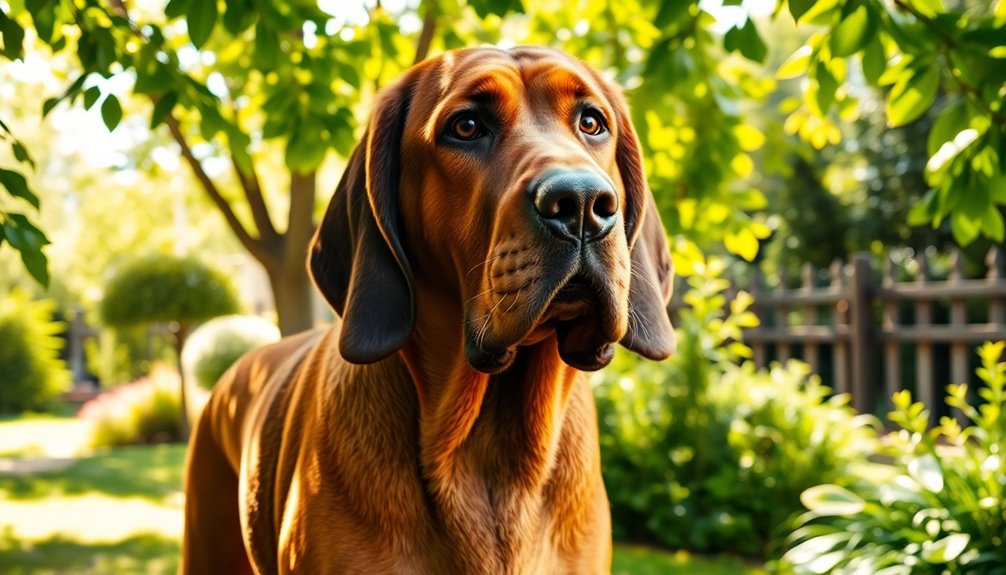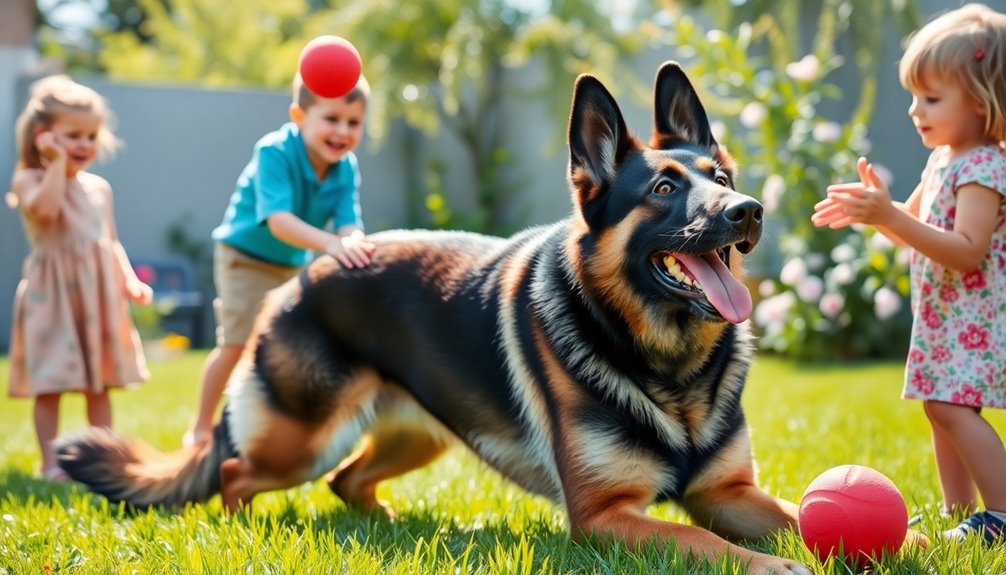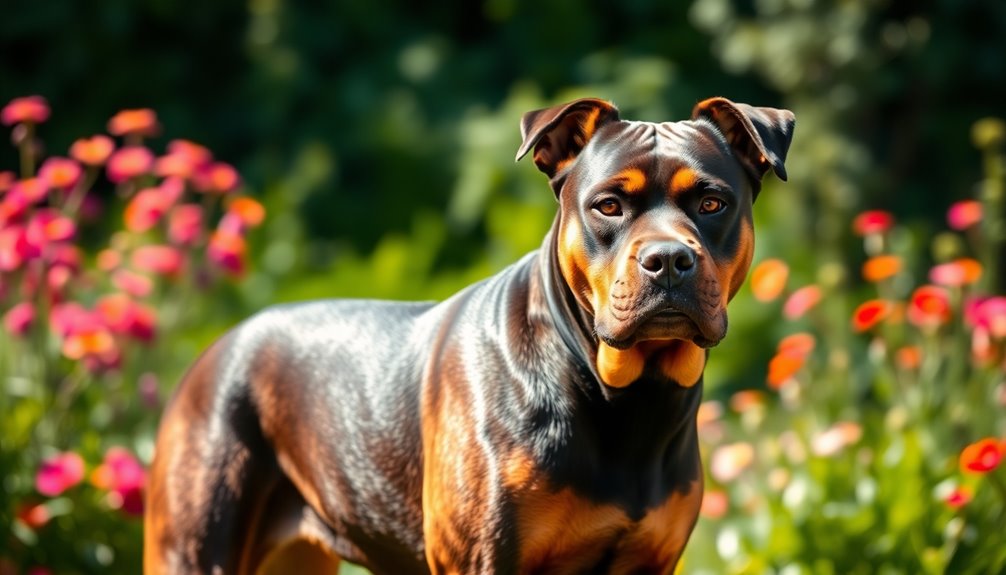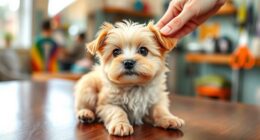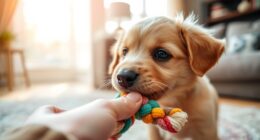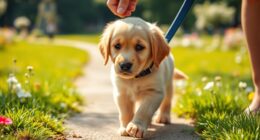Owning a Bloodhound is a rewarding commitment that requires understanding their unique traits. These affectionate dogs excel in scent tracking and need regular exercise to stay healthy. Grooming is essential, with weekly brushing and daily ear care to prevent infections. Training starts early, emphasizing obedience and socialization, which builds trust. They're known for their stubbornness, so patience is key. Health monitoring is vital, especially for issues like hip dysplasia. Make certain they have a balanced diet and plenty of mental stimulation to keep them engaged. As you discover more, you'll find tips to help your Bloodhound thrive in all aspects of life.
Key Takeaways
- Bloodhounds require regular exercise and mental stimulation to maintain health and prevent behavioral issues.
- Consistent grooming, including ear and dental care, is crucial to prevent infections and maintain hygiene.
- Early training and socialization help develop well-adjusted behavior and manage their strong scent-following instincts.
- A balanced diet and regular vet check-ups are essential for monitoring health and preventing obesity-related conditions.
- Engaging in scent-tracking activities allows Bloodhounds to utilize their powerful sense of smell while keeping them mentally stimulated.
Bloodhound Breed Overview
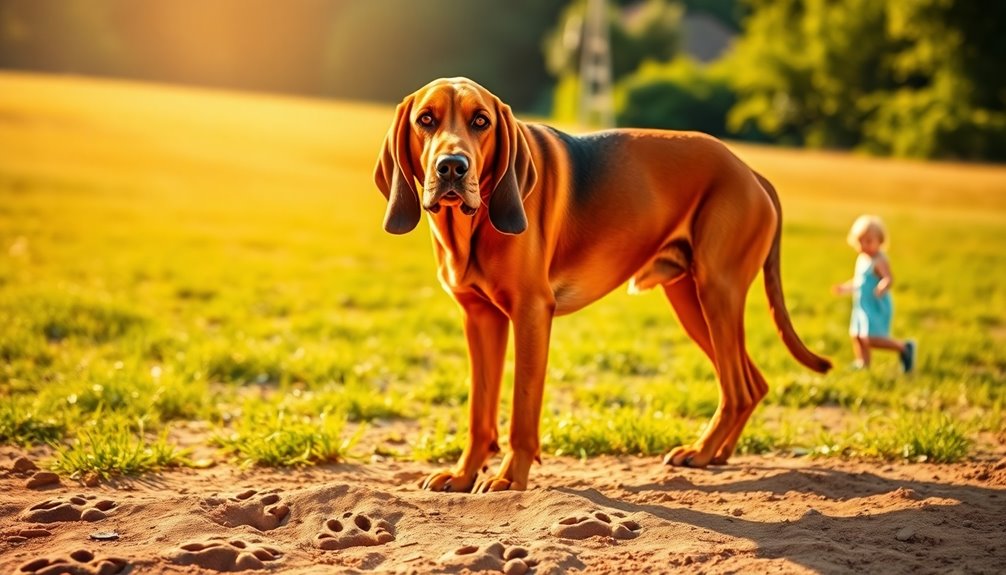
When you think of a Bloodhound, you might picture a dog with an incredible sense of smell and a lovable personality. This breed, renowned for its powerful scent-tracking abilities, ranks 53rd in popularity among the 201 breeds recognized by the AKC.
Males typically stand 25-27 inches tall and weigh between 90-110 pounds, while females are slightly smaller, measuring 23-25 inches and weighing 80-100 pounds.
Bloodhounds are classified under the Hound Group and have a life expectancy of 10-12 years. Their health can be maintained through regular exercise and proper training, which is essential for this active breed. Given their exceptional tracking skills, Bloodhounds excel as tracking dogs, often being referred to as "Sleuth Hounds" due to their prowess in search-and-rescue operations.
Owning a Bloodhound means committing to their physical and mental well-being, ensuring they get enough exercise to keep them happy and healthy. With consistent training, they can become not just loyal companions but also skilled helpers in locating lost individuals.
Unique Traits and Abilities
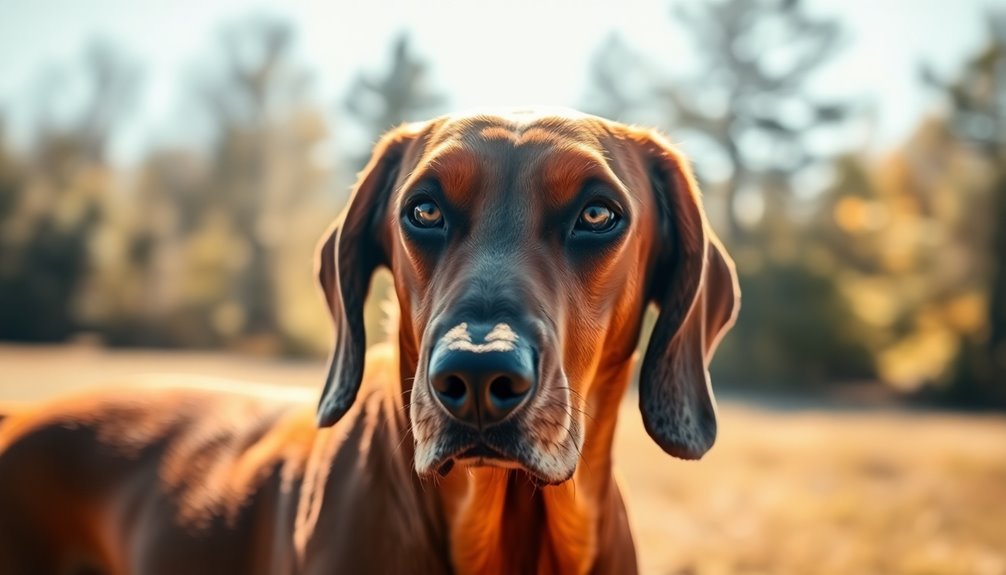
Bloodhounds are truly remarkable dogs, especially when it comes to their unique traits and abilities. Their exceptional sense of smell is estimated to be 1,000 times more powerful than yours, making them unmatched in scent detection and tracking abilities. This incredible talent has earned them the nickname "Sleuth Hound," as they've long been utilized in search and rescue operations.
Their droopy ears and loose skin aren't just cute features; they actually enhance their scent-trapping capabilities, allowing them to follow scents more effectively.
While Bloodhounds are generally docile and affectionate, their strong instincts can lead to stubbornness, which is where consistent training comes into play. For best results, use positive reinforcement methods during training sessions. This approach helps you maintain control while fostering a trusting relationship with your Bloodhound.
However, keep in mind that you should also be aware of potential health issues that may arise in this breed, as they can affect their performance. By understanding their unique traits and abilities, you can guarantee a fulfilling partnership with your Bloodhound that highlights their natural gifts.
Care and Grooming Needs

Caring for a Bloodhound involves regular grooming and attention to their unique needs. As a responsible Bloodhound owner, you must prioritize their hygiene to prevent health concerns. Daily grooming is important, especially for their eyes and ears, which need to be wiped to avoid buildup and infections.
Their short, dense coat sheds, requiring weekly brushing with tools like rubber gloves or Furminators to manage loose hair.
Here are three key grooming tasks you should focus on:
- Face Cleaning: Bloodhounds tend to drool, so you must regularly clean their face to prevent skin issues. Wipe their jowls with a damp cloth to keep them fresh.
- Ear Care: Use unscented baby wipes to clean their ears weekly, removing dirt and food residue. Regular ear cleaning is essential to avoid infections.
- Dental Hygiene: Brush their teeth weekly with dog-specific toothpaste to maintain oral health.
In addition to grooming, make sure they get plenty of exercise to keep them healthy. Regular veterinary care is important, especially when sourced from responsible breeders.
Keeping a clean living environment is also critical, given their drooling and shedding tendencies.
Training and Socialization Tips
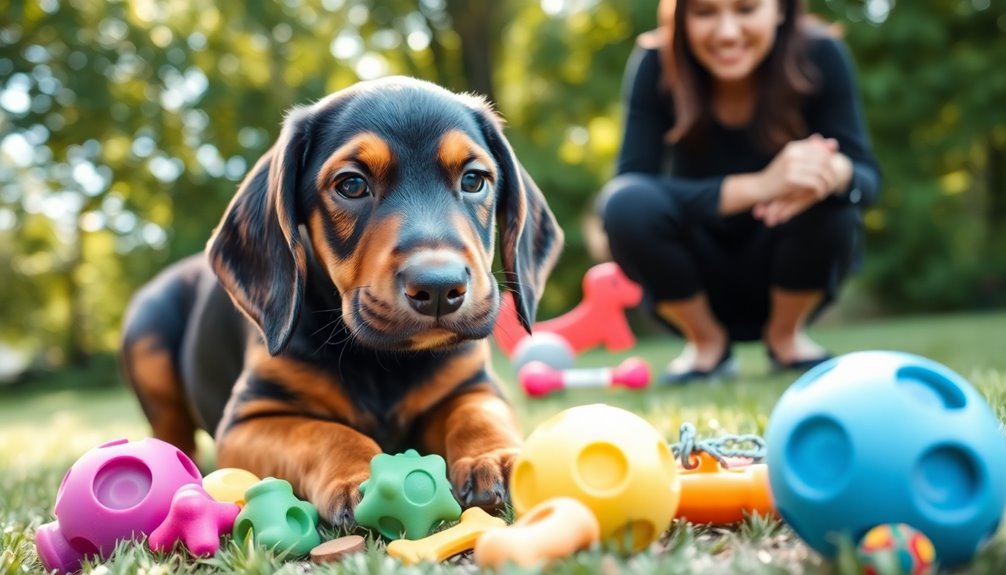
From the moment you bring a Bloodhound home, training and socialization become crucial to guarantee they grow into well-adjusted companions. Early obedience training is key, as these dogs can be independent and stubborn. Consistent guidance helps them learn effectively.
Using positive reinforcement techniques—like treats and praise—works wonders with Bloodhounds. They thrive on rewards rather than forceful methods. Socialization is equally important; expose your pup to various people, pets, and environments during their critical developmental stages (4-8 months and 8 months to 2 years) to prevent behavioral issues.
Leash training is essential too. Their strong scent-following instincts can lead to wandering if not properly managed. Incorporate mental stimulation into training sessions, like scent tracking challenges, to channel their energy and keep them engaged.
Here's a quick reference table for your training approach:
| Training Focus | Techniques | Benefits |
|---|---|---|
| Obedience Training | Positive Reinforcement | Encourages good behavior |
| Socialization | Exposure to new experiences | Reduces fear and aggression |
| Leash Training | Consistent commands | Guarantees safety during walks |
Embrace these tips for a happy, well-trained Bloodhound!
Health Considerations and Monitoring
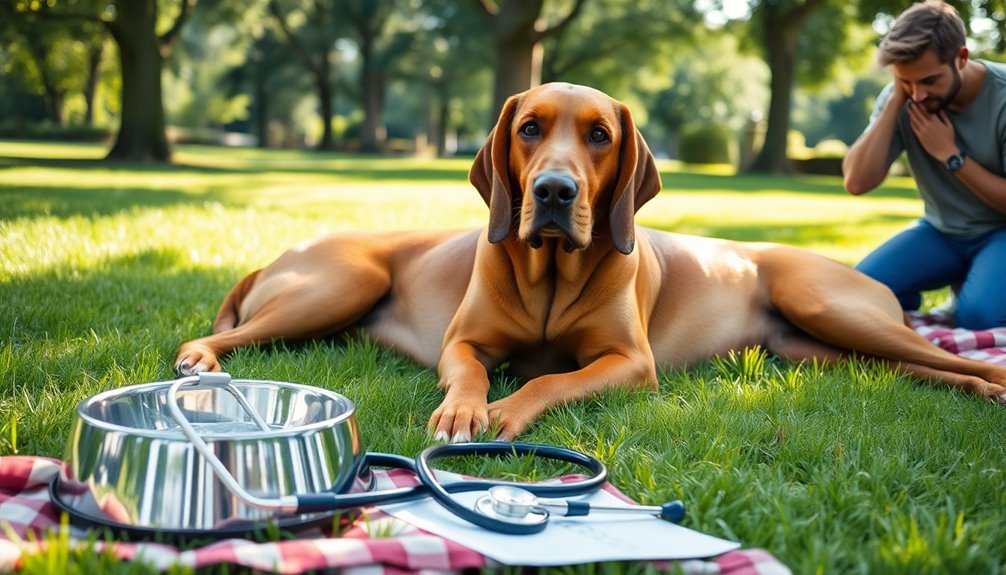
As a Bloodhound owner, it's essential to be aware of common health issues like hip dysplasia and eye problems.
Regular vet check-ups help you catch potential conditions early, ensuring your dog stays healthy and happy.
Keeping an eye on their weight and overall well-being can make a significant difference in their quality of life.
Common Health Issues
When it comes to owning a Bloodhound, being aware of common health issues is essential for ensuring your pet's well-being.
Bloodhounds are prone to certain health concerns that can affect their quality of life. By recognizing these issues early, you'll be better equipped to keep your furry friend healthy and happy.
Here are three common health issues to watch for:
- Hip Dysplasia: This genetic condition can lead to arthritis due to improper alignment of the pelvic and thigh bones. Early detection is key for managing pain and mobility.
- Gastric Dilation Volvulus (GDV): Also known as bloat, GDV is a life-threatening condition that can cause the stomach to twist. Look for symptoms like an enlarged abdomen and seek immediate veterinary attention if you notice any.
- Ear Infections: Due to their droopy ears, Bloodhounds need routine cleaning to prevent infections. Regularly check for excessive itching or irritation, as these can indicate an underlying issue.
Regular Vet Check-ups
How often do you think about your Bloodhound's health? Regular veterinary check-ups are essential for keeping your furry friend in top shape. Bloodhounds are prone to specific health issues like hip dysplasia and bloat, which require early detection and management. For adult Bloodhounds, it's recommended to schedule vet visits at least once a year, while puppies need more frequent check-ups for proper growth and vaccinations.
Here's a quick reference table to keep track of important vet check-up aspects:
| Check-up Aspect | Frequency |
|---|---|
| Adult Health Evaluation | At least once a year |
| Puppy Health Evaluation | Every 3-4 months |
| Eye Examination | Every 6 months |
| Weight Monitoring | At every visit |
| Dental Health Check | Every 6-12 months |
Maintaining a healthy weight is vital, as obesity can worsen hip dysplasia and increase the risk of bloat. Regular check-ups will also monitor your Bloodhound's dental health, ensuring they stay happy and healthy throughout their lives.
Exercise Requirements and Activities
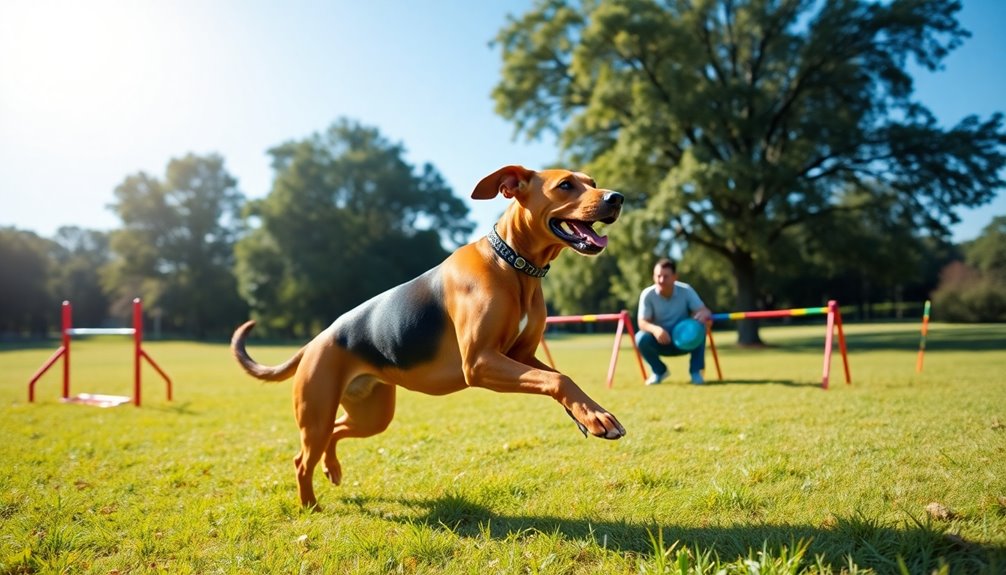
Daily exercise is essential for keeping your Bloodhound happy and healthy, requiring about 1 to 2 hours of activity. This breed thrives on mental and physical stimulation, so meeting their exercise requirements is vital.
For young Bloodhound puppies, you'll need to provide shorter, less intense sessions to avoid joint strain and support proper growth.
Here are three enjoyable activities you can incorporate into your daily routine:
- Brisk Walks or Jogging: Take your Bloodhound for a brisk walk or jog to help them burn off energy while enjoying the outdoors.
- Scent-Tracking Challenges: Engage their strong scent-following instincts by hiding treats or toys for them to find. This is a fantastic way to provide mental stimulation.
- Interactive Games: Play games that encourage problem-solving, like hide-and-seek, to keep their minds sharp and prevent boredom.
Frequently Asked Questions
Are Bloodhounds Hard to Own?
Did you know that Bloodhounds have an incredible sense of smell, capable of detecting scents over 300 feet away?
Owning a Bloodhound can be challenging due to their independent nature and high energy levels. You'll need to commit 1-2 hours daily for exercise and training.
Their grooming needs, especially for droopy ears, and potential health issues add to your responsibilities.
If you're ready for the commitment, they can be wonderful companions.
How to Properly Take Care of a Bloodhound?
To properly take care of a bloodhound, you need to guarantee they get 1-2 hours of daily exercise, like brisk walks and scent tracking.
Regular grooming is essential, so clean their eyes and ears daily and brush their coat weekly.
Feed them high-quality kibble, shifting to two meals a day by six months.
Consistent training and socialization from a young age, along with routine vet check-ups, will help keep your bloodhound healthy and happy.
Can Bloodhounds Be Trusted off Leash?
Can bloodhounds be trusted off-leash? The answer's complicated.
On one hand, they've got an incredible sense of smell, which might lead them to wander off.
On the other hand, their independent nature means they might ignore your commands when they catch a scent.
To keep them safe, you should always exercise them in securely fenced areas or on a leash.
It's a simple choice: safety over freedom.
What Is the Life Expectancy of a Bloodhound?
The life expectancy of a Bloodhound typically ranges from 10 to 12 years.
To help your Bloodhound live a long, healthy life, focus on genetics, diet, exercise, and overall health care. Regular vet check-ups are essential, and a balanced diet can make a big difference.
Keep an eye out for common health issues like hip dysplasia and bloat, and guarantee your dog maintains a healthy weight with plenty of exercise.
Conclusion
Owning a Bloodhound is like having a furry detective by your side, sniffing out adventures and secrets with unmatched zeal! These gentle giants are more than just pets; they're your loyal companions, ready to track down every crumb and cuddle their way into your heart. With their unique traits and lovable quirks, they'll turn your home into a bustling headquarters for fun. So, get ready—your life is about to be filled with tail wags and nose-to-the-ground excitement!

